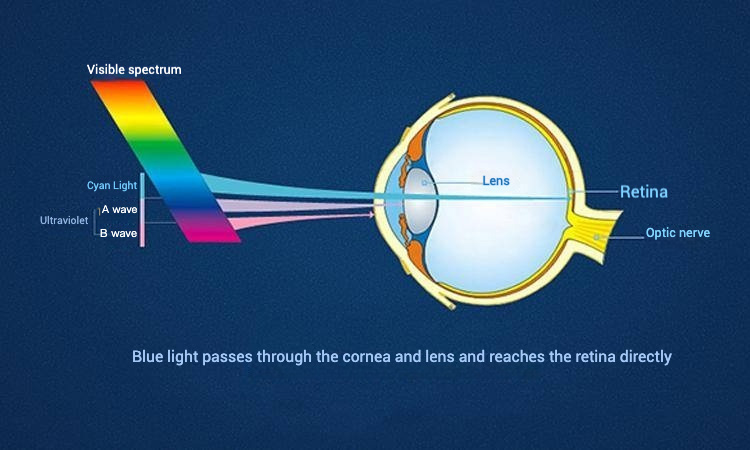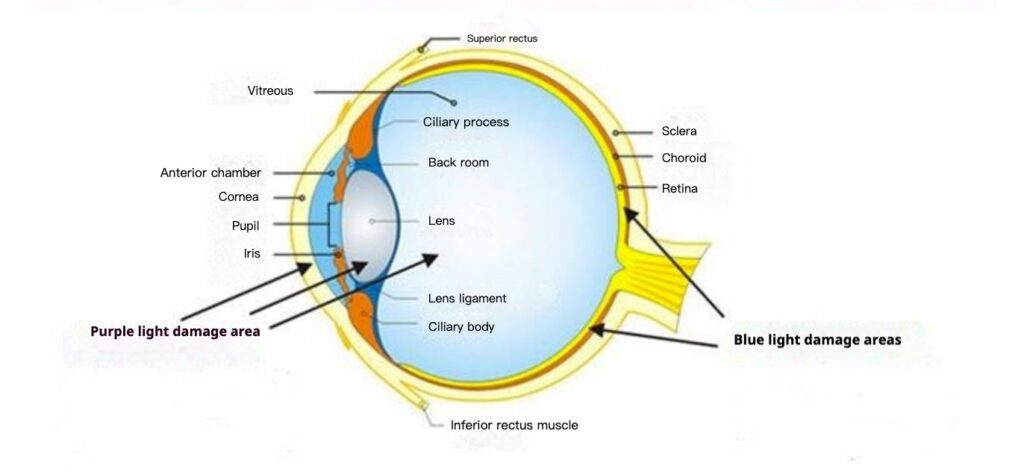Short-wave blue light refers to light with wavelengths between 400nm and 450nm, which carries relatively high energy. Blue light within this range can increase the level of toxins in the macular area of the eye, posing a serious threat to retinal health. Blue light is widely present in computer monitors, fluorescent lights, smartphones, digital devices, displays, and LED lighting. Prolonged exposure can severely impact our eye health.

In daily life, blue light is everywhere, but the most harmful blue light we encounter mainly comes from LED LCD screens. Modern LCD displays use LED backlighting, which aims to produce white light. To achieve this, the industry typically uses blue LEDs combined with yellow phosphor to create white light. Since the core component is the blue LED, the resulting white light spectrum contains a blue light peak, leading to the issue of harmful blue light that can damage the eyes.
Ordinary blue light does not harm the eyes; the real threat comes from high-energy short-wave blue light. This type of blue light increases the level of toxins in the macular region of the eye and poses a serious risk to our visual health.
As early as 1966, research by Nell et al. found that exposure to blue light can cause retinal cell damage, leading to vision deterioration or even permanent loss of sight.
Among all blue light wavelengths, those between 400–450 nanometers carry the highest energy and pose the greatest threat to the retina.
At the 2010 Annual Meeting of the International Commission on Illumination (CIE), leading global optical experts unanimously pointed out that short-wave blue light carries extremely high energy and can penetrate the eye’s lens and directly reach the retina. Blue light exposure to the retina produces free radicals, which lead to the death of retinal pigment epithelial (RPE) cells. When RPE cells deteriorate, photoreceptor cells lose vital nutrients, resulting in irreversible vision damage.

Damage to Eyes: Harmful blue light carries high energy that can penetrate the eye’s lens and reach the retina. This can lead to the atrophy and even death of retinal pigment epithelial cells, resulting in diminished or complete loss of vision, which is irreversible. Additionally, prolonged exposure to blue light can contribute to maculopathy.
Visual Fatigue: Due to its shorter wavelength, blue light focuses slightly in front of the retina rather than directly on it. This forces the eye to remain under constant tension to maintain clear vision, leading to eye strain. Prolonged visual fatigue can cause issues such as worsening myopia, double vision, difficulty in focusing while reading, and reduced productivity, negatively impacting learning and work efficiency.
Poor Sleep Quality: Blue light suppresses melatonin production, a hormone critical for sleep and regulating circadian rhythms. This explains why using phones or tablets before bedtime can disrupt sleep, causing difficulty falling asleep and poor overall sleep quality.
The main function of blue light blocking lenses is to reduce part of the harmful blue light that can damage the eyes, making screen time in front of a computer more comfortable. However, there is currently no conclusive evidence that they can effectively relieve symptoms such as eye strain, dryness, vision deterioration, or prevent retinal diseases. Therefore, it’s important to be cautious of exaggerated marketing claims in the market.
Blue light blocking lenses must first meet the standards of qualified optical lenses and should be capable of filtering a certain percentage of blue light. Typically, standard blue light blocking optical lenses filter about 30% of blue light. Not all blue light is harmful to the human body—about 30% is generally considered the harmful portion, while the remaining blue light is actually beneficial. It is recommended to choose lenses produced by reputable, well-known manufacturers to ensure both optical quality and effective blue light protection.
Secondly, blue light blocking lenses can be divided into two main categories:
In terms of performance, both types offer similar levels of blue light protection, but the coated lenses generally use more advanced technology and provide better overall optical quality.
Additionally, even for individuals without vision problems, it is advisable to choose high-quality optical lenses from trusted sources. Be cautious with ready-made non-prescription glasses—it is better to have the lenses custom-made, as lens quality plays a crucial role in ensuring both wearing comfort and visual effectiveness.
Claims of “eye protection” with exaggerated blue light blocking effects are often marketing hype.Be cautious of products that use fear-based advertising—such as graphic images or alarming messages—to magnify the dangers of blue light. These are clear signs of manipulative marketing tactics. Avoid products that fail to disclose their lens manufacturer. Developing high-quality optical lenses requires decades of technical expertise. Marketing may be loud and flashy, but true optical craftsmanship comes from years—if not decades—of experience. Currently, no eyewear retail brand in the world possesses the R&D capability to produce advanced optical lenses on their own. The main reason they launch private label lenses is often to prevent customers from price comparisons, not to improve quality.
We use lenses manufactured by Conant, a globally renowned lens manufacturer known for its balance of quality and affordability. Founded in 1996, Conant has developed mature and advanced lens production technology over nearly 30 years. As of 2020, Conant ranks as the ninth-largest lens manufacturer in the world, with products exported to over 80 countries and regions worldwide.

© 2025 All rights reserved
Keep your face forward, centered, and level. Just for style reference. Not Size.